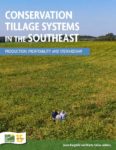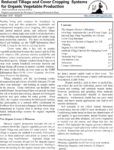The educational materials listed on this page are about Strip Tillage.
Strip tillage is a conservation tillage system where only the seed bed is tilled, leaving plenty of crop residue to surround the crop rows. It is similar to zone tillage but soil disturbance is much shallower and requires less energy. This type of tillage is beneficial for production systems that require a dryer and warmer seedbed. Strip tillage can be used on conventional and organic vegetable farms, especially if using a cover crop. Learn more about other reduced tillage options in Building Soils for Better Crops.
Showing 1-4 of 4 results

Conservation Tillage Systems in the Southeast
This production manual provides comprehensive guidance on conservation tillage systems for farms in the southeastern United States. It covers the core components of conservation tillage systems and includes both regional considerations and producer experiences.
Farmer Panel on Cover Crops
Farmers Skip Paul (Rhode Island), Jeff Frey (Pennsylvania) and Perry Lilley (Maine) share their experiences with cover crops, including their motivation for using them, successes and challenges, factors that play into decision making around cover crops, and advice for ag service providers who want to encourage farmer adoption of this vital conservation practice.

Integrating No-Till or Strip-Till with Cover Crops
Maximize soil conservation and soil health benefits of cover crops by combining this practice with no-till or strip-till systems.

Reduced Tillage and Cover Cropping Systems for Organic Vegetable Production
This information sheet captures research by Virginia Tech and the Virginia Association for Biological Farming to develop cover crop-based, reduced-tillage systems for organic vegetable production.